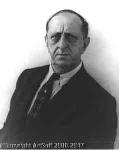Marsden Hartley
Marsden Hartley
Place: Lewiston
Born: 1877
Death: 1943
Biography:
Early Life and Training
Marsden Hartley, an American Modernist painter, poet, and essayist, was born on January 4, 1877, in Lewiston, Maine. He was the youngest of nine children to English parents who had settled in the United States. After his mother's death at the age of eight, Hartley's father remarried, and he was left behind in Maine to work in a shoe factory for a year. This period of loneliness would later influence his artistic perspective.
Artistic Career
In 1892, Hartley joined his family in Cleveland, Ohio, where he began his art training at the Cleveland School of Art. He then moved to New York City in 1898 to study painting under William Merritt Chase at the New York School of Art and later attended the National Academy of Design. Hartley's friendship with Albert Pinkham Ryder, coupled with the writings of Walt Whitman and American transcendentalists, inspired him to view art as a spiritual quest.
Notable Works and Exhibitions
- The Ice Hole (1908), now at the New Orleans Museum of Art, marked Hartley's transition into mature works. - Autumn Color (ca. 1910), showcased at the Metropolitan Museum of Art, reflects his early engagement with modernism. - Portrait of a German Officer (1914), also at the Metropolitan Museum of Art, embodies his experience with European modernist painters.
Later Life and Influence
After returning to the United States in 1916, Hartley continued to paint across the country. In 1937, he declared his intention to become "the painter of Maine," aligning himself with the Regionalism movement. This period is characterized by works such as Mt. Katahdin (Maine), Autumn -2 (1939–40), now at the Metropolitan Museum of Art.
- View Marsden Hartley's Artworks on Wikioo.org
- Explore the Greatest Paintings of All Time
- Read more about Marsden Hartley on Wikipedia
- Marsden Hartley was a pivotal figure in American Modernism. - His work reflects a spiritual quest influenced by transcendentalists and modernist painters. - Notable works include The Ice Hole, Autumn Color, and Portrait of a German Officer. - Hartley's later life was marked by his association with the Regionalism movement, focusing on depicting American life at a local level.
Wikipedia link: Click Here














